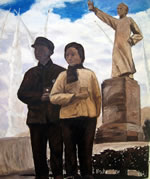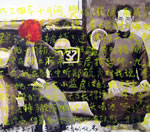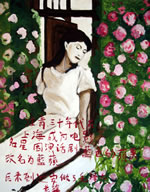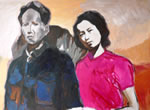 |
|
|
|
|
|
|
Gang ZHAO
*1961 Beijing; lives and works in Songzhuang
Curriculum Vitae: PDF |
Gang ZHAO is a philosophical painter with a cavalier touch. His lighthearted paintings of zodiac animals, waterfalls and houses are drawn from illustrations in historical Chinese books but are rendered in a predominantly Western style.
|
 |
| Wedding |
Born in Beijing in 1961, Zhao grew up during the Cultural Revolution. He entered the Central Academy of Fine Arts after it reopened following Mao Zedong`s death in 1976, but soon dropped out to join a radical group of artists know as the Stars. The Stars were avant-garde band of self-taught artists who rebelled against existing esthetic standards and political authority. In the 1980s he studied art at the Academy of Fine Arts in Maastricht, and philosophy at Vasser College; he received an MFA from Bard College in 1999.
|
|
| Untitled |
By updating old images in a new style, the artist fearlessly aims at a form of painting that provokes thought as much as it stirs the eye. Yet, considering Zhao’s radical roots and intellectual pursuits, the end results are more decorative than profound. |
 |
| Untitled |
Born in China, trained in Europe and a citizen of the US since 1989, is Gang ZHAO Eastern or Western? A product of cultural revolution ideology, or a politically committed painter in the tradition of Leon Golub or Luc Tuymans?
Gang ZHAO first studied painting on a full scholarship to Vassar, and then graduated from Bard College with an MFA in Video and Film. Yet he was also a participant in the infamous “Star Group” exhibitions in Beijing in 1979. The Star Group, the first self-organized community of post-Mao avant- garde artists, mounted a series of unauthorized art exhibitions starting in the fall of 1979. Seminal in Chinese art history, they were the first steps in the expansion of expressive freedom for Chinese artists; the exhibition was shut down after only two days.
|
 |
| Untitled |
The contradictions of Gang ZHAO ’s life are mirrored in his art. He is the Chinese painter who has truly mastered the painterly abstract gestures of western art, mixed it up with the deeply embedded propagandistic images of his childhood in Maoist ideology and synthesized it all into a hybrid international style with a wry, sarcastic sense of humor.
His work, The Americans are Here is a perfect example of this hybrid fusion. In this lushly rendered image of a Muslim platoon, the artist depicts the soldiers staring out towards the viewer. He paints, with the bravura abandon of the truly committed, yet he does so as an outsider. We don’t see the Americans, we see the reaction to their arrival. The painting is confrontational and full of expectation — is the army the subject or the object of this work? In other words, Gang, whose side are you on?
|
 |
| The Unknown Future |
In Manchu Commander ZHAO lovingly portrays Jing Bi Huia, female commander of the Manchurian army, in soft brushwork and seductive skeins of paint. A mythical figure, she was China’s 20th C. version of Joan of Arc. Subversively painting her with the soft-focus intimacy usually reserved for close ups of movies stars, she was his Brittany Spears — the media darling who became the object of his adolescent fantasies and desires.
Gang has managed to achieve what many Chinese artists are struggling with — a full immersion and understanding of cultural traditions, iconography, and visual techniques of east and west. He is eating his cake and having it too.His work, The Americans are Here is a perfect example of this hybrid fusion. In this lushly rendered image of a Muslim platoon, the artist depicts the soldiers staring out towards the viewer. He paints, with the bravura abandon of the truly committed, yet he does so as an outsider. We don’t see the Americans, we see the reaction to their arrival. The painting is confrontational and full of expectation — is the army the subject or the object of this work? In other words, Gang, whose side are you on?
In Manchu Commander ZHAO lovingly portrays Jing Bi Huia, female commander of the Manchurian army, in soft brushwork and seductive skeins of paint. A mythical figure, she was China’s 20th C. version of Joan of Arc. Subversively painting her with the soft-focus intimacy usually reserved for close ups of movies stars, she was his Brittany Spears — the media darling who became the object of his adolescent fantasies and desires.
Gang has managed to achieve what many Chinese artists are struggling with — a full immersion and understanding of cultural traditions, iconography, and visual techniques of east and west. He is eating his cake and having it too.
|
 |
| The Couples |
| |
|
| |
|
|
|
|
|